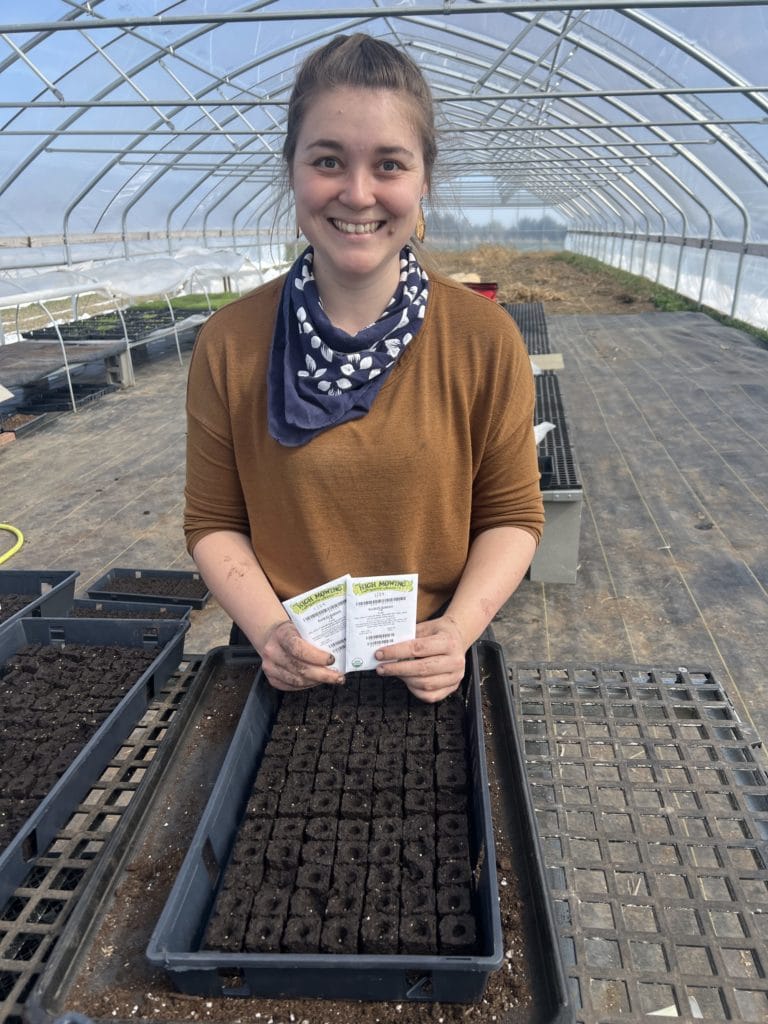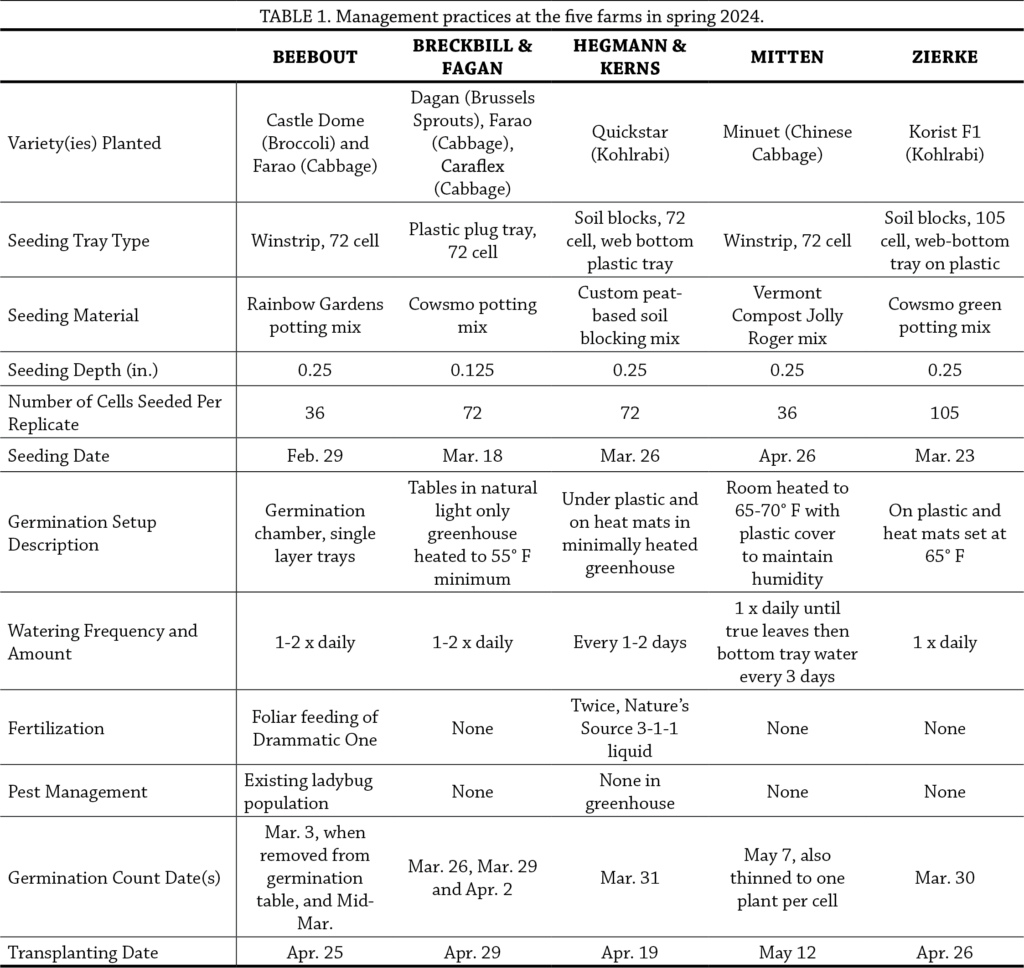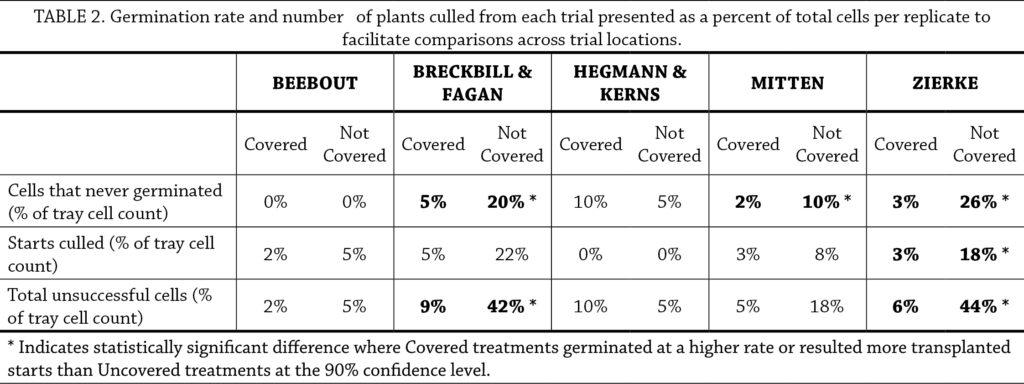This research report was funded by Stranahan Foundation, Walton Family Foundation and Ceres Trust.
In a Nutshell:
- Starting seedlings for transplant in the greenhouse is a chore where small, repeated components like covering seeds with soil can add up to a lot of time.
- A group of cooperators wondered if covering seeds is worth their labor and results in higher germination rates and/or healthier starts. Many members of the group start more brassicas for transplant than any other crop family, so they chose to study the effects of covering or not covering brassica seeds on germination rates and transplant viability.
Key Findings
- Three out of five trials found that covering brassica seeds resulted in higher germination rates, and one location found that covering resulted in more plants that were healthy enough to be transplanted.
- While all cooperators concluded that covering seeds is preferred to leaving them uncovered, several say that they will consider not covering seeds to save time when they are behind on greenhouse work.
Background
PFI farmers are no strangers to experimenting with their transplanting methods and greenhouse setups in the effort to minimize costs, reduce labor and produce high-quality transplants. Previous studies have shown that starting peppers in soil blocks may lead to more productive plants [1] and Cowsmo potting soil works as well as more expensive brands [2], among other findings [3, 4]. This spring, Jill Beebout, Hannah Breckbill & Emily Fagan, Natasha Hegmann & Pete Kerns, Roxane Mitten, and Carly & Ethan Zierke set out to determine whether they could save time and effort while still producing healthy brassica seedlings by skipping the usual “cover the seeds with soil” step when planting into seed starting trays/soil blocks in the greenhouse. As Mitten reported and others echoed, time and workflow complexity are critical stressors for many at this busy early part of the growing season, and eliminating a potentially unnecessary step would be welcome. This trial design was relatively simple and completed by most in about a month, and as such was perfect as Carly & Ethan Zierke’s first research trial. At the outset, Ethan hoped “that the experience will provide me with the skills and confidence I need for the other trials we have lined up for this season and beyond.”
Methods
Design and measurements
All five farms seeded four replicates of each treatment, Covered and Uncovered, and arranged them in a completely randomized design in their germination and growing setups. Some farms seeded each treatment in a separate tray while others split trays between Covered and Uncovered treatments, depending on space and number of desired transplants (see Figure A1). Farmers used their existing germination and transplant growing setups, which varied across trial locations (Table 1). For each trial, farmers recorded planting and management details.
Quantitative data recorded for this trial included a count of seeding tray cells where seeds did not germinate. Farmers determined what day to record germination rate based on when they moved their trays from germination to growing setups or when they determined that any additional plants germinated would be too far behind the others to be transplanted. Several farmers recorded germination counts at multiple dates; for data analysis purposes, only germination rate recorded at the latest date was analyzed and presented here. Prior to transplanting, farmers also counted seedlings that germinated and grew but were deemed not suitable for transplanting.
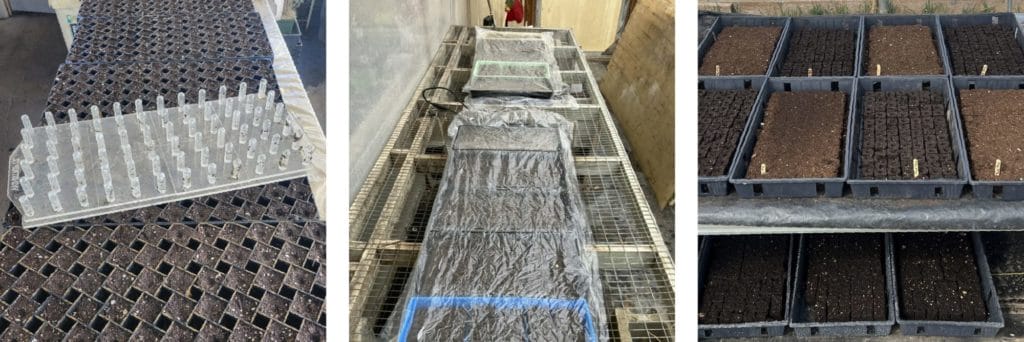
Left: Jill Beebout’s winstrip seeding trays and dibbler for quickly creating holes. Center: Natasha Hegmann and Pete Kern’s germination setup: trays on heat mats and covered in plastic in a minimally heated part of the greenhouse. Right: Carly and Ethan Zierke’s germination setup: heat mats and a plastic low tunnel within a high tunnel. Photos taken Feb.-Mar. 2024.
Data analysis
We used a T-test at a 90% confidence level to determine if there were significant differences in Covered and Uncovered treatments. A T-test is used to determine if the measured values of two groups differ from each other significantly and takes into account variability seen in the replicates. 90% confidence means that if the trial were repeated in the same way we would expect to see the same results nine times out of 10. We can perform this statistical analysis because the cooperators used completely randomized and replicated experimental designs (Figure A1).
Results and Discussion
Germination
Breckbill & Fagan, Mitten, and the Zierkes all observed that their Covered treatment had a statistically higher germination rate than the Uncovered treatment (Table 2). Emily Fagan noted that “covered seeds germinate and grow much better.” All five of the farms had slightly different seeding trays and mediums and germination and transplant growing setups, which likely influenced differences in germination rate and transplant growth. For example, Ethan Zierke observed that “Uncovered seeds may not perform well in our systems because on warm days we open the tunnel and plants are exposed to wind and surface is allowed to dry out to prevent disease. We observed some uncovered seeds moving around, maybe because of the wind.” Similarly, Mitten was concerned that the uncovered seedlings were much more fragile at first germination than the covered ones, and accordingly had to adjust her watering method and add shade for the seedlings when placing them out in her growing setup.
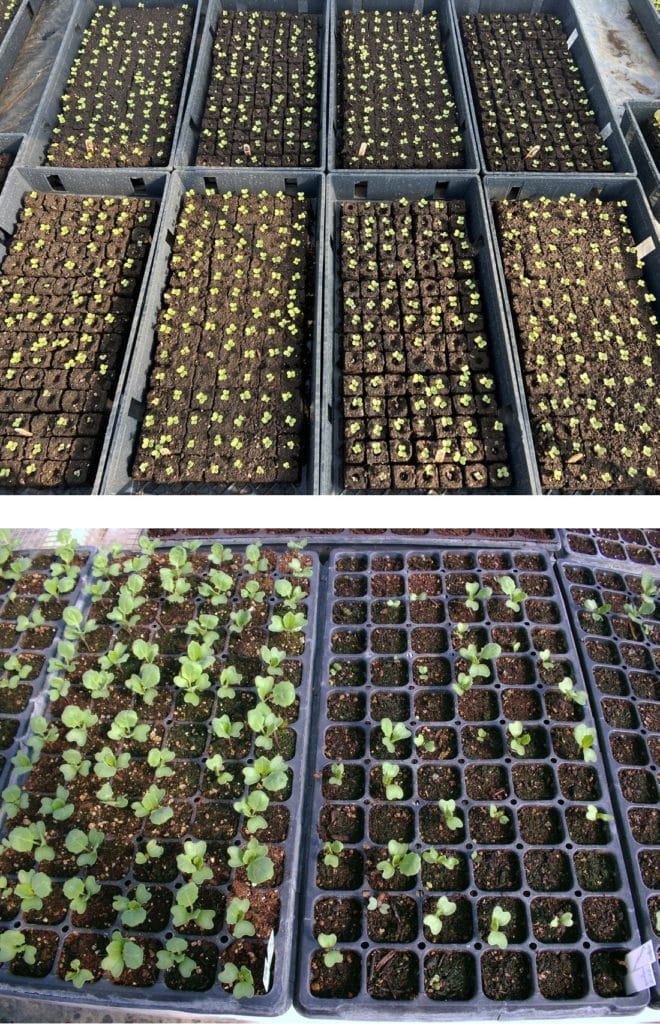
Top: Germinated seedlings in covered and uncovered treatments in Carly and Ethan Zierke’s trials. Uncovered treatments have visible holes in the middle of soil blocks and have fewer germinated seeds (example bottom left). Photo taken Mar. 30. Bottom: Germinated seedlings in covered (left) and uncovered (right) treatments at Hannah Breckbill and Emily Fagan’s. Photo taken Mar. 26.
Transplant viability
Zierkes’ was the only trial where we observed that the number of plants culled at transplant was statistically significantly higher in the Covered treatment compared to the Uncovered treatment (Table 2). “In uncovered trays, the plants are less healthy in general, including rumpled, yellow-looking plants and possible signs of dampening off. The uncovered trays appear a day behind in growth,” Ethan Zierke reported. While they did not observe a statistically significant difference in number of plants culled between treatments, several other farms also observed that the plants from the Uncovered treatment were smaller and less healthy. For example, Mitten snapped pictures at transplant (see below) showing a clear visual difference between Covered and Uncovered treatment plant size.
In contrast, Beebout reported that “visually, the transplants were very similar,” and Hegmann & Kerns did not cull any plants from either of their seed covering treatments. Beebout started her transplants several weeks earlier than any other participant, and Beebout and Hegmann & Kerns were the only farmers that fertilized their starts during the trial, which likely increased the vigor of their seedlings (Table 1).
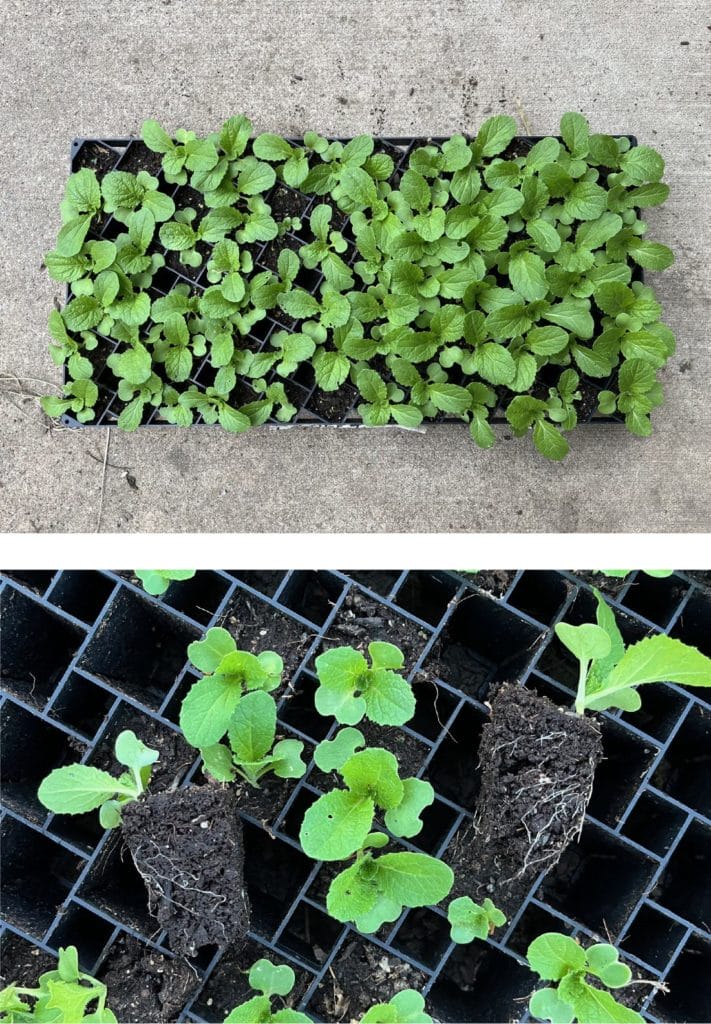
Top: Roxane Mitten’s starts just before transplant. The covered seed treatment starts (right side) are clearly larger and healthier than the uncovered seed treatment plants (left side). Bottom: Roots on Roxane Mitten’s starts at transplant. Plant on the left is from the uncovered seed treatment, and the plant on the right is from the covered seed treatment. Photos taken May 12, 2024.
Conclusions and Next Steps
These trials show that in many cases, covering brassica seeds with soil when starting transplants leads to better germination rates and better transplant viability. “As a beginning farmer, there are countless things we do daily because we think we need to, or because a mentor did it that way. It’s always a good feeling to implement a practice that is supported by experience and data. I now have data that encourages me to keep covering trays for best results,” Ethan Zierke concludes. While everyone agrees that covering sown seeds will be Plan A for the spring seeding workflow, Beebout also notes that on her farm, there were few consequences to not covering seeds. “If I’m in a time crunch, I might push forward with uncovered seed until I get caught up.”
Appendix – Trial Design and Weather Conditions

Figure A1. Example experimental design with four replicates per treatment used by Jill Beebout, Hannah Breckbill & Emily Fagan, Natasha Hegmann & Pete Kerns, Roxane Mitten, and Carly & Ethan Zierke. Trays with treatments were laid out in a randomized fashion in both germination and growing setups. Some cooperators split trays between treatments while others seeded a whole tray for each treatment.
References
[1] L. Kolbe, S. Jutz, and C. Black, “Pepper Seedlings in Soil Blocks and Plug Trays,” Practical Farmers of Iowa, 2015. [Online]. Available: https://practicalfarmers.org/research/pepper-seedlings-in-soil-blocks-and-plug-trays/
[2] E. Liddle, H. Breckbill, E. Fagan, and J. Yagla, “Potting Soil Comparison for Vegetable Seedling Quality,” Practical Farmers of Iowa, 2020. [Online]. Available: https://practicalfarmers.org/research/potting-soil-comparison-for-vegetable-seedling-quality/
[3] L. Kolbe, S. Jutz, T. Landgraf, J. Libbey, E. Franzenburg, and A. Franzenburg, “Energy Use and Cost of Starting Seedlings at Three Iowa Farms,” Practical Farmers of Iowa, 2013. [Online]. Available: https://practicalfarmers.org/research/energy-use-and-cost-of-starting-seedlings-at-three-iowa-farms/
[4] L. Kolbe, J. Beebout, C. Black, and K. Edwards, “Pelleted Seed and Covered Trays for Summer Lettuce Germination,” Practical Farmers of Iowa, 2018. [Online]. Available: https://practicalfarmers.org/research/pelleted-seed-and-covered-trays-for-summer-lettuce-germination/


